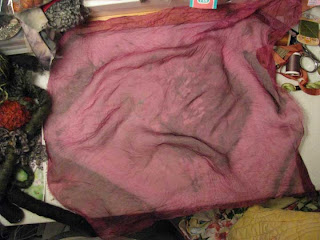Why I don’t Eco-Dye Fabric
I do, however, dye, paint, and print, my fabric with natural dyes.
Photo courtesy of the Main Street Cultural District Ames, Iowa.
I participated in a local art walk last Friday and after three hours of questions about my natural dyed scarves, artwork, etc., I am once again reminded as to why I don’t call myself an eco-dyer, for the most part nobody is interested in the craft of eco-dyeing!
While most people play lip service to protecting the environment, sustainability, fair trade practices, and all things “green” the fact of the matter is when most people found out that I was using tree bark, mushrooms, leaves, bugs, and other stuff to dye my art cloth the response was an overwhelming “that’s nice” or “that’s really cool”. "That’s nice" is the kiss of death, it's the Mid westerners version of “so what” or “who cares”!
The whole experience solidified in my mind what I already knew, while there are some that are truly concerned about the environment and sustainability, the majority only cares if it saves them a buck or two. Which leads me back to why I don’t eco-dye my fabric, fibers, and threads, but in fact dye them with Natural Dyes, to me it’s about the process and the relationships I form with other dyer’s, and most importantly with nature that surrounds and inspires me.
Natural dyed silk scarves.
For me the process is not about immediate gratification, but about discovery, learning, exploring, and most importantly relationships. Unless a local woodworker gifts me a bag of wood chips from their dust collection system or from their lathe turnings, the wood, barks, and roots I use to create my designs are collected over a period of years, often time’s decades.
My finished artwork was a hit with everyone with plenty of people telling me they’d love to be able to stitch and sew like I do and do I teach classes? The evening wasn't a total bust, I got plenty of hits from women of all ages that are interested attending a stitching party; the older women of course were very excited about the wine aspect of said parties.
Click here to learn more about eClasses, Workshops, and my newest offering Out of the Box Art Parties!
Click here to learn more about eClasses, Workshops, and my newest offering Out of the Box Art Parties!



















